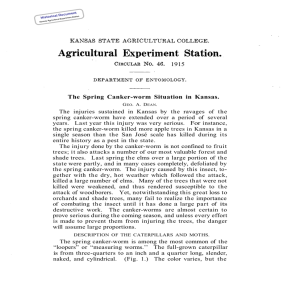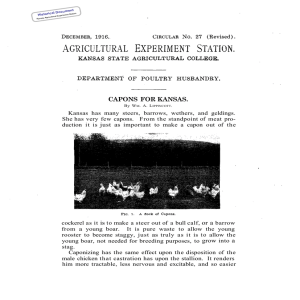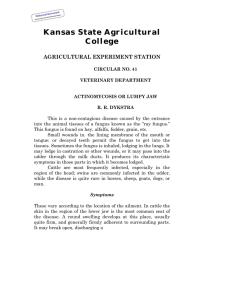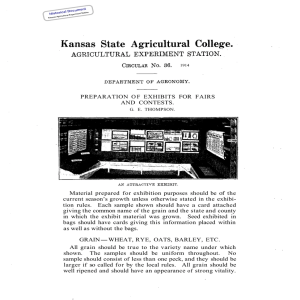1, Kansas Live Stock Remedy Law, with List of ... Registered April 1915.
advertisement
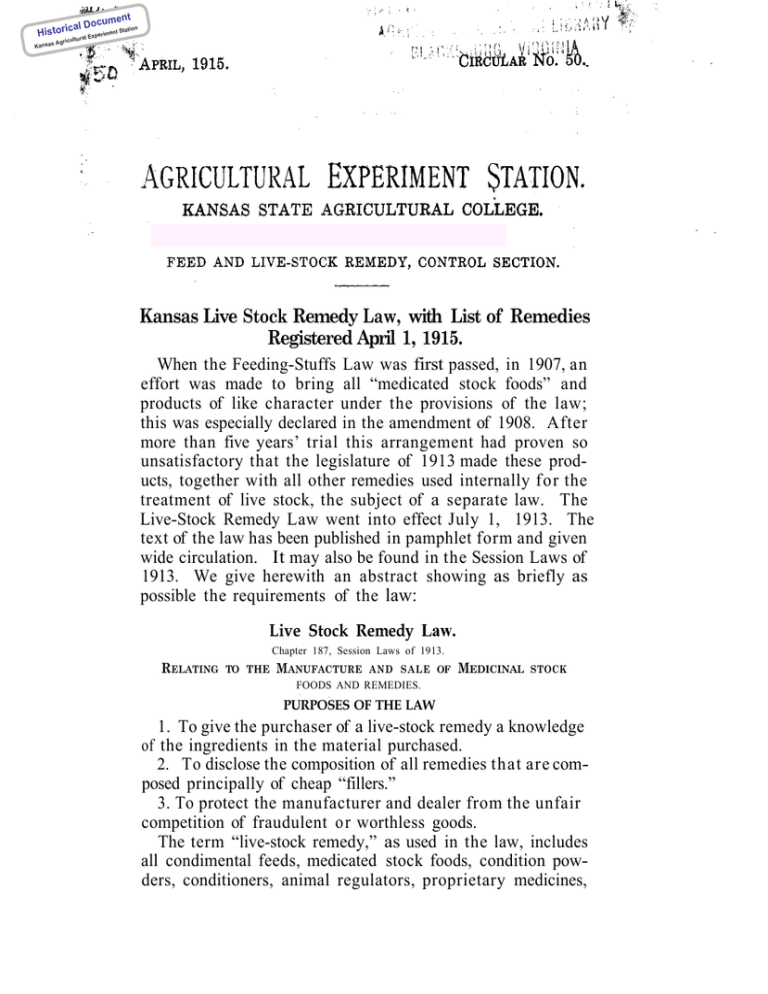
t cumen n io cal Do Histori tural Experiment Stat Kansas Agricul Kansas Live Stock Remedy Law, with List of Remedies Registered April 1, 1915. When the Feeding-Stuffs Law was first passed, in 1907, an effort was made to bring all “medicated stock foods” and products of like character under the provisions of the law; this was especially declared in the amendment of 1908. After more than five years’ trial this arrangement had proven so unsatisfactory that the legislature of 1913 made these products, together with all other remedies used internally for the treatment of live stock, the subject of a separate law. The Live-Stock Remedy Law went into effect July 1, 1913. The text of the law has been published in pamphlet form and given wide circulation. It may also be found in the Session Laws of 1913. We give herewith an abstract showing as briefly as possible the requirements of the law: Live Stock Remedy Law. Chapter 187, Session Laws of 1913. RELATING TO THE MANUFACTURE AND SALE OF FOODS AND REMEDIES. PURPOSES OF THE LAW MEDICINAL STOCK 1. To give the purchaser of a live-stock remedy a knowledge of the ingredients in the material purchased. 2. To disclose the composition of all remedies that are composed principally of cheap “fillers.” 3. To protect the manufacturer and dealer from the unfair competition of fraudulent or worthless goods. The term “live-stock remedy,” as used in the law, includes all condimental feeds, medicated stock foods, condition powders, conditioners, animal regulators, proprietary medicines, t cumen n io cal Do Histori tural Experiment Stat Kansas Agricul or any preparation of like nature, in either solid or liquid form, designed for any animal except man, and administered internally. All live-stock remedies, as defined above, for internal use must be registered with the director of the Experiment Station of the Kansas State Agricultural College at Manhattan, Kan. The application for registration must be a sworn statement, giving the English name of each ingredient contained in the remedy, also the actual percentages of any of the following substances: mineral acids; the following elements or their salts: copper, mercury, arsenic, antimony, and phosphorus; the following substances or any of their derivatives or preparations : opium, belladonna, nux vomica, pilocarpus, santonin, areca nut, wormwood, digitalis, strophanthus, calabar bean, aconite, veratrum, croton oil, ergot, cotton-root bark, and cantharides. The maximum percentage of “filler,” including such substances as common salt, charcoal, sulphur, earth, humus, elevator dust, or other like substances, must also be shown. Every sack, box, carton o r other package of live-stock remedy sold in the state of Kansas must bear a label or tag showing: 1. The name and principal address of the manufacturer. 2. The name, brand or trade-mark under which the remedy is sold. 3. The English name of each ingredient used in the manufacture of the remedy, together with the percentages required in the application. The package must also bear a tax stamp or tag, which the manufacturer is required to purchase, to show the payment of a tax of two cents per hundred pounds or pints. Stamps or tags are made in denominations of five, ten, fifteen, twenty, twenty-five, thirty, fifty, and one hundred pounds. Payment for tags or stamps must be forwarded to the director of the Experiment Station of the Kansas State Agricultural College at Manhattan, Kan. It is then paid into the state treasury each month, and is used for the purpose of enforcing the Live-Stock Remedy Law. A live-stock remedy can not be registered under a name, brand or trade-mark that is misleading or deceptive, or under a label that does not truthfully state the materials of which t cumen n io cal Do Histori tural Experiment Stat Kansas Agricul it is composed. When the manufacturer has registered a remedy no other person will be required t o register it. The enforcement of the Live-Stock Remedy Law is placed in the hands of the director of the Experiment Station of the Kansas State Agricultural College at Manhattan, Kan., and either he o r his authorized deputy shall have free access t o all places of business, and shall have the power and authority to open any parcel of whatsoever kind used in the manufacture and sale of live-stock remedies for the purpose of making inspection of such remedies. Representative samples of each brand of live-stock remedy sold or offered for sale in the state of Kansas shall be taken by the director of the Experiment Station of the Kansas State Agricultural College a t Manhattan, Kan., or by his authorized deputy, for inspection and analysis. These representative samples shall be the unbroken orginal packages whenever practicable. The facts concerning the violations of the Live-Stock Remedy Law shall be certified by the director of the Experiment Station to the proper prosecuting attorney, and in all prosecutions the certificate of analysis o r examination, duly sworn t o by a person authorized to make such analysis or examination, shall be prima facie evidence of the facts certified to such prosecuting officer. The penalty for the violation of the Live-Stock Remedy Law is a fine of not to exceed one hundred dollars ($100) for the first offense and not less than one hundred dollars ($100) for each additional offense; all penalties recovered t o be paid into the school fund of the county where the offense is committed. The Live-Stock Remedy Law is not a law intended to raise revenue. The rate of tax (2 cents per hundred pounds or pints) is so small that no manufacturer can reasonably complain of the tax being burdensome. Hence no manufacturer need hesitate to meet the requirements of the law unless the plain statement upon the label of the ingredients used makes it impossible for him to persuade the consumer to buy his goods. In such cases the consumer is simply getting the protection he justly deserves. Some of the manufacturers have simply failed to comply with the law; a few have positively refused to comply, and have withdrawn their remedies from sale in this state. The livestock remedies produced by these manufacturers are barred t cumen n io cal Do Histori tural Experiment Stat Kansas Agricul from sale in the state until the manufacturers meet the requirements of the law. The names of those refusing to register are given below, together with the names of the remedies formerly offered for sale by them : S. R. Feil Company, Cleveland, Ohio. Sal-Vet. Fleming Brothers, Chicago, Ill. Tonic Heave Remedy; Colic Cure. Giles Remedy Company, Chicago, Ill. Magic Lotion and Blood Purifier. H. Clay Glover, New York City, N. Y. Full line of remedies. Humphrey’s Homeopathic Medical Co., New York City, N. Y. Entire list of veterinary remedies. Rsnsdell’s Stock Food Co., Clay Center, Kan. “Make Em Lay” Poultry Food. John Robbins, Greensburg, Ind. Sal-Tone. United Drug Company, Boston, Mass. Entire list of Elkay remedies. A number of remedies in which common salt is the principal ingredient have been withdrawn from sale in the state, because the Live-Stock Remedy Law requires the manufacturers to state on the label the maximum percentage of salt used. Poultry remedies composed of shorts and a small amount of Epsom salts are no longer found on sale, simply because the manufacturer refuses t o so label his goods as to tell his customers what they are getting. No customer would willingly pay at the rate of $22.60 per hundredweight for wheat shorts containing a little Epsom salts. No live-stock remedy which complies with the law will be denied the privilege of sale in Kansas, and the remedies hereafter offered for sale will be sold upon their merits, as each package will be labeled to show the ingredients and net weight. CONCENTRATED LYES. The class of remedies which have heretofore been sold in the state, such as Merry War Lye and other concentrated lyes offered for sale as live-stock conditioners and cures for various animal diseases, are also brought under the provisions of the Live-Stock Remedy Law, and in all cases where these products are offered o r exposed for sale as live-stock remedies for internal use they must state on the outside of the package the net weight and the various ingredients. Such investigations as have been conducted do not seem t o bear out the claims made as to the value of these so-called remedies. Directions for feeding shown on the cans advise the same dosage and advertising claims the same curative action on brands of lye varying in purity from 98 per cent to 77.25 per cent. The t cumen n io cal Do Histori tural Experiment Stat Kansas Agricul directions often printed on the can show the use of from onefourth to one-half a can to one barrel of water. The standard barrel of water containing 6400 ounces, and the ordinary can of lye containing 12 ounces, the results of the combination, to say the least, would be doubtful, while the results from the use of lye in increased strength has, in many cases, proved fatal. This product, if classed as a remedy, might be used as an alkaline in cases of sour stomach and similar ailments. As a vermifuge we can find no proof that it is at all satisfactory. A little consideration of this matter will raise a doubt in the mind of any person as to the curative properties of concentrated lye. It should be borne in mind at all times that there are no “cure-alls” among live-stock remedies any more than among remedies for human beings. Unless the owner of an animal is sure of his diagnosis, the safest and best plan is for him to employ a competent veterinarian, whose advice should be followed. We give below some of the ingredients usually found in live-stock remedies. The list shown contains a number of the drugs commonly used in veterinary medicines, with their common names, and indicates the general effect these drugs may have. This list is in no sense intended to be a condensed “materia medica.” It should be borne in mind that the list given is not intended as a recommendation of any remedy or class of remedies. These drugs have the effects shown, and may also have other effects. Nearly all drugs are more or less poisonous when given in large doses. In combination with other drugs, the effect of any of them may be altered. The action indicated, however, will be applicable in most cases and will add to the information that the statement of the various ingredients of the remedy, as shown on the label, is intended to give. Acacia.-Demulcent. Aconite.-Depressant, Aloes.-Cathartic. Aloin (see Aloes) .-Purgative. Alum.-Powerful astringent, American Wormseed.-Anthelmintic. Antimony (sulphurated) .-Emetic. Antimony trisulphide (see Antimony). Aniseed-Aromatic; carminative. Areca nut.-Anthelmintic. Arsenic (poison) .-Tonic. Asafetida.-Stimulant; antispasmodic. t cumen n io cal Do Histori tural Experiment Stat Kansas Agricul t cumen n io cal Do Histori tural Experiment Stat Kansas Agricul List of Firms Registering Live-Stock Remedies. The following list gives the names of all firms registered in Kansas, together with the names of remedies registered by each : t cumen n io cal Do Histori tural Experiment Stat Kansas Agricul t cumen n io cal Do Histori tural Experiment Stat Kansas Agricul t cumen n io cal Do Histori tural Experiment Stat Kansas Agricul t cumen n io cal Do Histori tural Experiment Stat Kansas Agricul t cumen n io cal Do Histori tural Experiment Stat ul Agric Kansas t cumen n io cal Do Histori tural Experiment Stat Kansas Agricul t cumen n io cal Do Histori tural Experiment Stat Kansas Agricul t cumen n io cal Do Histori tural Experiment Stat Kansas Agricul
